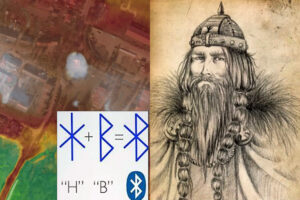At first glance, the name Harald Gormsson might not mean much to RFID Journal’s readership, and understandably so. However, that historical individual has a fascinating, albeit peripheral, connection to the wireless technologies sector.
 Gormsson reigned as the King of Denmark during the late 10th century A.D. and is best known for having introduced Christianity to Scandinavian countries, thereby unifying that part of the world. Harald also ruled Norway for a time, as well as Jutland and Zealend. During his reign, he oversaw the reconstruction of several public works, commissioned the Ravning Bridge, spearheaded the creation of numerous ring forts and refortified the kingdom’s Aros fortress.
Gormsson reigned as the King of Denmark during the late 10th century A.D. and is best known for having introduced Christianity to Scandinavian countries, thereby unifying that part of the world. Harald also ruled Norway for a time, as well as Jutland and Zealend. During his reign, he oversaw the reconstruction of several public works, commissioned the Ravning Bridge, spearheaded the creation of numerous ring forts and refortified the kingdom’s Aros fortress.
Harald is believed to have died in 985 A.D., but the location of his burial site has long remained an archeological mystery. Clearly, however, none of this is relevant to RFID Journal’s coverage area, so why am I even mentioning it here? It’s because Harald, according to historians, had a dead tooth that had rotted so badly in his mouth, it had turned a dark shade of blue. Hence his nickname, “Blåtand,” which translates into English as “blue tooth.”
As reported last week by The First News, Heritage Daily and various other websites, a research team led by Marek Kryda recently applied space-based reconnaissance to pinpoint any potential archaeological disturbances in Poland. In so doing, the team located a Viking burial mound beneath a Roman Catholic church in the village of Wiejkowo, which the scientists have confirmed to be King Harald’s burial site, a possibility first speculated by Swedish archaeologist Sven Rosborn.
 Without the Viking monarch, a different nomenclature would have been adopted for the short-range wireless technology standard used for data exchange between devices via UHF radio waves. But thanks to Harald’s dental rot, we now have the name “Bluetooth.” The designation was chosen in Gormsson’s honor, for just as King Harald brought Denmark’s tribes together as a unified kingdom, Bluetooth technology unites wireless devices. The Bluetooth logo, in fact, comprises a pair of Scandinavian runes signifying the King’s initials.
Without the Viking monarch, a different nomenclature would have been adopted for the short-range wireless technology standard used for data exchange between devices via UHF radio waves. But thanks to Harald’s dental rot, we now have the name “Bluetooth.” The designation was chosen in Gormsson’s honor, for just as King Harald brought Denmark’s tribes together as a unified kingdom, Bluetooth technology unites wireless devices. The Bluetooth logo, in fact, comprises a pair of Scandinavian runes signifying the King’s initials.
We in the IoT world owe a minor debt of gratitude to Harald “Bluetooth” Gormsson. Had the man practiced better oral hygiene, Bluetooth technologies might have been named after someone else entirely—a famous pirate, perhaps. The term “BLE” might well have stood for “Blackbeard Low Energy.”
Rich Handley has been the managing editor of RFID Journal since 2005. Outside the RFID world, Rich has authored, edited or contributed to numerous books about pop culture. You can contact Rich via email.

